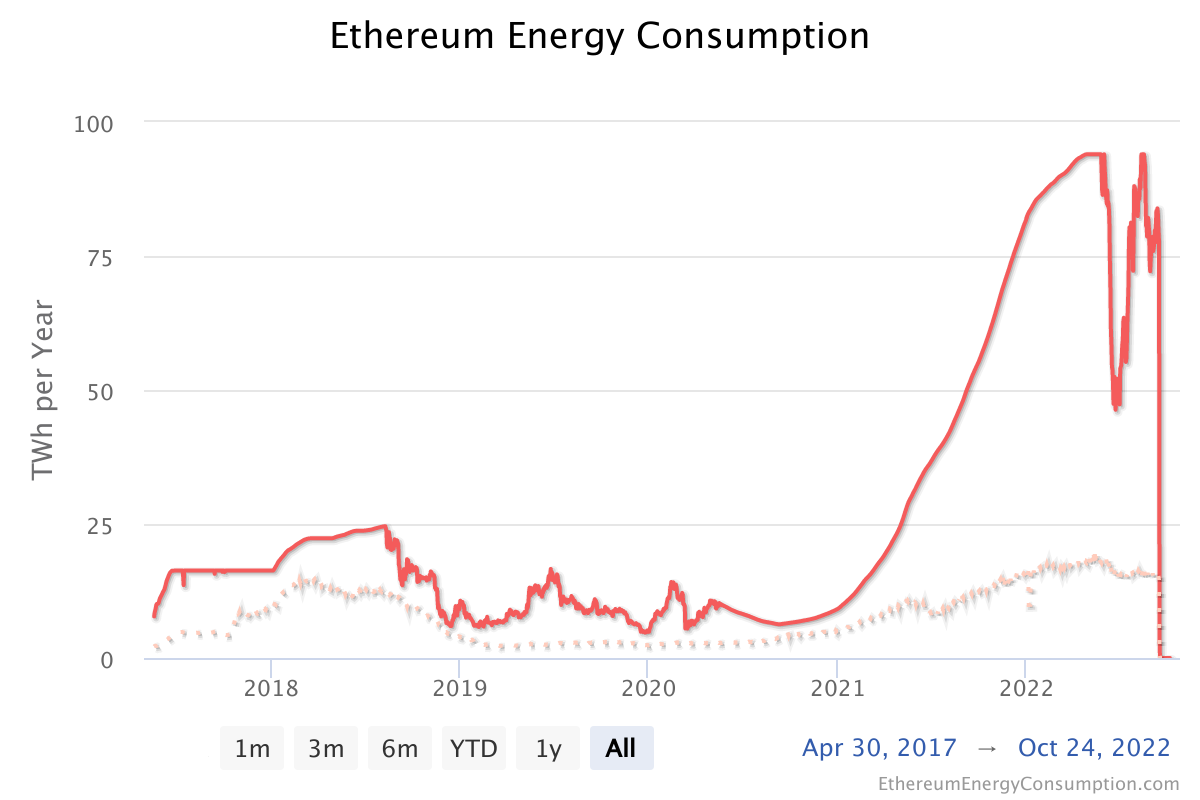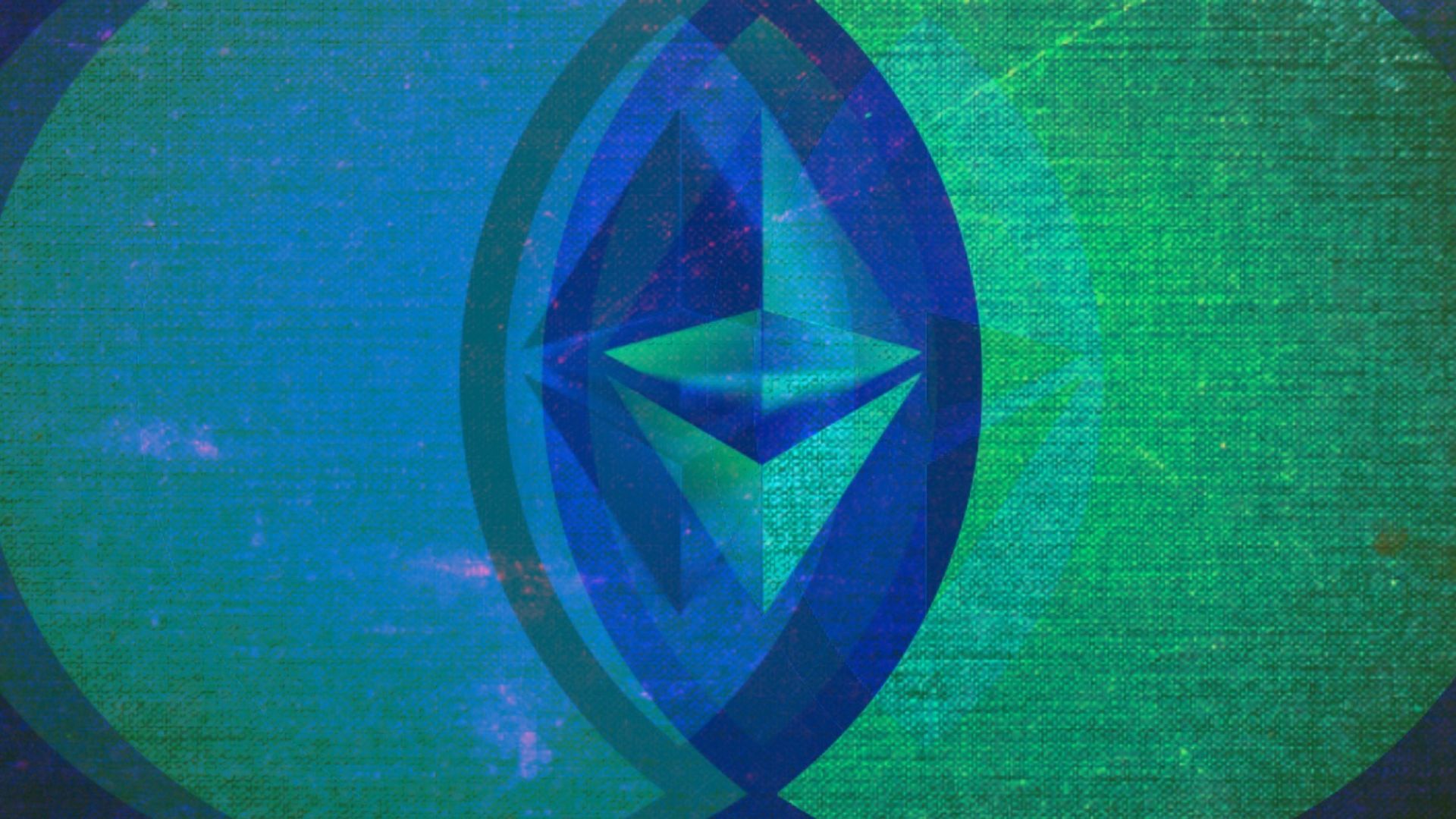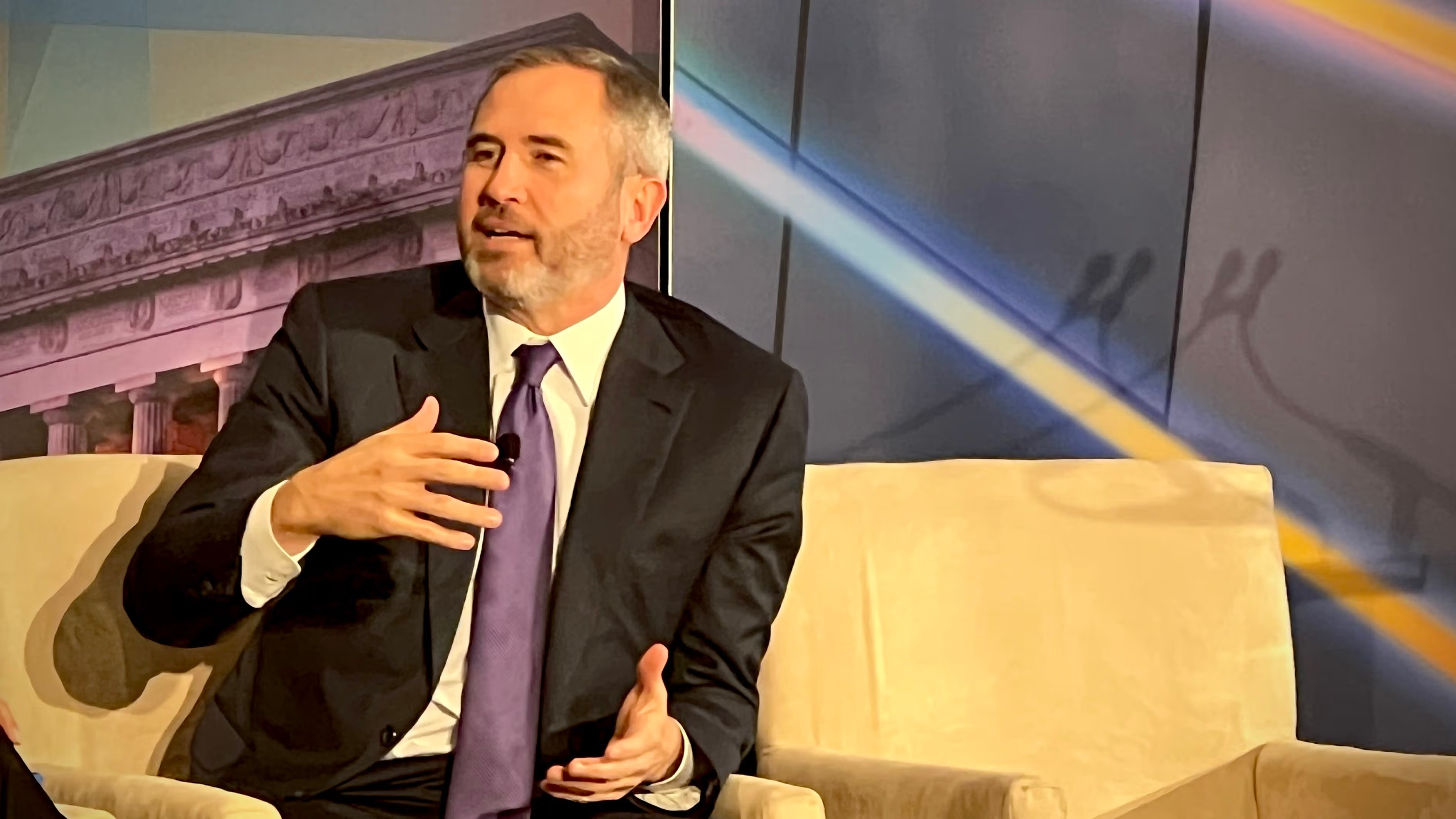The Ethereum merge is still fresh. Not even a month has passed since the second-largest blockchain switched from an energy-intensive proof of work validation mechanism to proof of stake, lowering its energy consumption by 99.5 percent.
But context clarifies the magnitude of this change. In the summer before the merge, Ethereum consumed nearly 60 tera-watt hours (TWh) per year, which was roughly on par with the country of Uzbekistan’s annual energy needs. It also meant that the blockchain had a carbon footprint comparable to Azerbaijan’s, emitting roughly 33 megatons (MT) of carbon a year.
Take a look at the graph below. See the part of the line plummeting to the bottom? That’s the effect of the September 15 Ethereum merge. Ethereum now uses roughly 0.01 TWh of energy per year, putting it below PayPal in terms of annual energy consumption. Given that one of the main concerns with blockchain technology (and, by proxy, NFTs) was directly related to its environmental impact, the conversation about the future of the NFT ecosystem in a post-merge landscape has become far more sustainable and thus productive. Likewise, the merge has opened up a crucial discussion about how society reacts to new and disruptive technologies.

The atmosphere of condemnation pre-merge
Much remains unanswered. And, while it’s still too early to say for certain how the merge will affect the Web3 landscape in the long term, some have begun to see hints of what could be its immediate effects.
“It’s a complex issue and it’s easy to misunderstand how things work,” said Jonathan Perkins, chief product officer and co-founder of SuperRare Labs, in an interview with nft now. “I do agree that most of the criticisms were misguided, and I think most of the intentions [behind them] were good. I’m an environmentalist and I’m very happy that we were able to switch to proof of stake.”
Perkins, along with Co-Founder and SuperRare Labs CEO John Crain, is no stranger to controversy in the NFT space. Having launched the SuperRare platform in 2018, the pair have seen the full gamut of criticisms launched at Web3 platforms and the artists who use them. Up until the merge, these condemnations became increasingly vitriolic.
“We started to see […] artists being demonized and attacked in a very aggressive and kind of traumatizing way online.”
Jonathan Perkins
“We’re used to taking a lot of stuff on the chin, as a company in this space,” Perkins continued. “But what we started to see last year is artists being demonized and attacked in a very aggressive and kind of traumatizing way online. And that’s when we decided we need to take the gloves off and really come out and help clarify this stuff. We basically said, ‘Say anything you want about us, but leave the artists alone.’ I’m a Bitcoin fan as well, but I think that from day one, the Ethereum community has set itself apart, making this intention clear that we’re using proof of work for an interim phase to get this network off the ground and prove the concept. But the goal [was] to become less energy intensive. I’m pretty proud of the community for that.”
This is one of many examples of how the proliferation of misinformation online can have tangible effects on people’s lived experiences. Blockchain and NFTs have long been hailed as inherently pro-artist technology, something that can help chip away at the demeaning “starving artist” trope that has haunted society for hundreds of years. The last thing creatives need is more unjustified stigmatization. Thankfully, the merge has done much to cut through these kinds of attacks.
Why merge optics matter to onboarding
The merge could be one reason platforms like SuperRare are seeing an uptick in activity. Take away the main worry many had about the Ethereum blockchain (justified or not), and you’ll find people who wanted to partake all along who now finally feel they can do so without a guilty conscience.
“It’s hard to know if it’s directly correlated with the merge, but we have seen transaction volume increase in the past few months,” noted SuperRare Labs CEO John Crain while speaking to nft now. “I think the merge is part of it. There were people on the sidelines who read the headlines and wanted to wait until Ethereum was proof of stake before minting things on it.”
This increase in activity could be a bullish omen for the future of the Ethereum chain and the countless platforms and apps built on it. The SuperRare founders have also caught wind of a general narrative shift in the NFT ecosystem, moving from a PFP and collectible-dominated ecosystem to a more inclusive environment that’s more appealing to those in the fine art space.
“There really is an artistic revolution happening. NFTs are a powerful base-layer technology that’s well-positioned to be the foundation of digital art.”
John Crain
“In general, we’ve seen an upswing in activity,” Crain continued. “We’re starting to see real traction from the more traditional fine art community. And I wouldn’t necessarily attribute that to the merge. But we’re seeing world-class galleries and artists who don’t come from a Web3 background but who see the power of the technology. There really is an artistic revolution happening. It’s not just Bored Ape Yacht Club. NFTs are a powerful base-layer technology that’s very well-positioned to be the foundation of digital art.”
Decentralization in a proof-of-stake system
Proof-of-stake validation isn’t without its potential problems. For example, the possibility of censorship remains an issue, and it works like this: The fewer validators there are in a system, or the larger the staking pool any one validator controls, the more centralized the network becomes. This situation has led some to fear the possibility of bad actors pushing validators into censoring the Ethereum protocol.
Crain and Perkins acknowledged the need to be on the lookout for such censorship, and advocated for more people to join as validators, to ensure a robust ecosystem. They also spoke to the whispers regarding SuperRare itself becoming a validator amongst members of the SuperRare DAO.
“There’s strong interest from people to run a validator as a community that’s built on top of the [Ethereum] platform,” Crain said of SuperRare DAO members’ desire to join the proof-of-work validation system. “As a council member, I would certainly support a move like that. It’s good for the whole ecosystem, it’d be a good use of the ETH that’s sitting in the community treasury. That seems like a very logical next step that the DAO could run a validator, maybe even more than one validator.”
Decentralization has always been a moving target in Web3 communities. The conversation surrounding when to bake decentralization into tangible rules in Web3 platforms versus when to use it as a broader guiding principle is unlikely to stop anytime soon. The SuperRare marketplace has itself been a compelling case study over the years regarding attempts to find and maintain this balance.
The platform has long held a reputation for curatorial exclusivity, but it’s also done what it can to step out of the way and give control to its users whenever possible. When the platform launched in 2018, the founders decided they would relinquish editorial control over what artists on its platform posted. Rather than having artists contact the platform via email with pieces they wanted to mint, Crain, Perkins, and SuperRare’s third Co-Founder, Charles Crain, let artists mint what they wanted without any approval process.
“There’s this kind of inherent polarity in crypto art,” Perkins observed of the decentralization dichotomy. “In the first few months of running the platform, we imagined that within 12 months, we would be stepping out of the way as gatekeepers and there would be AI algorithm curators filtering the art. It was just kind of obvious that we needed to grow to scale [first]. So, we instituted the least bad method of curating, having a phone call with any artists that wanted to get on the platform and adding a few per month to kind of scale up with the number of collectors that there were.”
“We try to increasingly delegate important parts of the power structure to the community.”
Jonathan Perkins
This, according to Perkins, was a natural and necessary step to building the platform up so that it could later become more decentralized.
“As a startup, we’ve done things that don’t scale, and I think our approach to exclusivity is one of them,” Perkins elaborated on their approach to building the platform over the years. “And the reason is that we wanted to help bootstrap a healthy collecting market. We never had an explicit desire to be exclusive, it was more of a necessary stepping stone. And what we’ve proven is that collectors respond to curation and authenticity.”
The creation of Spaces was one way the company tried to step out of the role of centralized gatekeeper. Spaces are independent galleries on the marketplace that curate, promote, and sell art, with each gallery voted into the network by SuperRare DAO members. The pair reiterated that not all aspects of centralization are bad, emphasizing the need for balance in aiming for the Web3 ethos.
“There have been projects that promise and attempt to complete decentralization on day one,” Perkins said of the importance of a slow approach to the matter. “And that often doesn’t work because of coordination issues. We had about three and a half years under our belts by the time we pivoted into being a DAO officially. We had customers, we had lots of artists and collectors, and we had a kind of product-market fit as a startup. And increasingly, we see ourselves as standards bearers in this space. We try to increasingly delegate important parts of the power structure to the community. I think it’s still important to be a strong voice rather than just stepping out and letting chaos ensue.”
Optimism for the future of NFTs
Ultimately, the two are hopeful for the long-term health and impact that NFTs seem destined to have. Bear markets and crypto winters aside, Perkins and Crain have confidence in the blockchain’s ability to become a widespread, everyday part of people’s lives.
“We’ve been building on Ethereum for five-plus years,” Perkins underlined. “NFT volumes are down from a USD perspective, but we’re actually continuing to see really strong collector activity on SuperRare. [The merge] gives me a lot more confidence and we’re all sleeping better at night. It’s a feather in the cap of this infrastructure. I met an artist over the weekend, a self-proclaimed digital artist who’s never minted anything because he didn’t want to jump on the bandwagon too early. I think there are a lot of people waiting to see if this technology will prove itself, whether it’s for environmental reasons or otherwise. And the more concrete steps toward scalability and sustainability that we can take, the more activity is going to fall into the gravity well.”
Read More: nftnow.com









 Bitcoin
Bitcoin  Ethereum
Ethereum  Tether
Tether  XRP
XRP  Solana
Solana  Dogecoin
Dogecoin  USDC
USDC  Cardano
Cardano  Lido Staked Ether
Lido Staked Ether  TRON
TRON  Avalanche
Avalanche  Sui
Sui  Wrapped stETH
Wrapped stETH  Toncoin
Toncoin  Chainlink
Chainlink  Shiba Inu
Shiba Inu  Wrapped Bitcoin
Wrapped Bitcoin  Stellar
Stellar  Hedera
Hedera  Polkadot
Polkadot  WETH
WETH  LEO Token
LEO Token  Bitcoin Cash
Bitcoin Cash  Litecoin
Litecoin  Uniswap
Uniswap  Pepe
Pepe  Hyperliquid
Hyperliquid  Wrapped eETH
Wrapped eETH  Ethena USDe
Ethena USDe  NEAR Protocol
NEAR Protocol  USDS
USDS  Internet Computer
Internet Computer  Aptos
Aptos  Aave
Aave  Mantle
Mantle  POL (ex-MATIC)
POL (ex-MATIC)  Cronos
Cronos  Ethereum Classic
Ethereum Classic  MANTRA
MANTRA  Render
Render  Bittensor
Bittensor  Monero
Monero  Tokenize Xchange
Tokenize Xchange  Dai
Dai  Artificial Superintelligence Alliance
Artificial Superintelligence Alliance  Arbitrum
Arbitrum  Virtuals Protocol
Virtuals Protocol